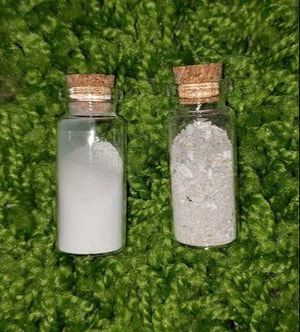Modern Mortician Admin
Why Water Cremains and Flame Cremains
React Differently on Grass and Soil
(image of a vial of water cremains on the left, and flame cremains on the right)

When families choose cremation, whether by flame or water (alkaline hydrolysis), they often imagine scattering ashes as a simple return to nature. But what happens after scattering depends heavily on how those cremains were created. Flame cremains and water cremains look and behave differently because of their chemical composition, texture, and pH balance. Understanding these differences helps families make informed decisions about where, and how, to spread them responsibly.
Flame Cremains: Dry, Alkaline, and Mineral-Heavy
Flame cremation reduces the body to bone fragments through high heat (1400–1800°F). These are then mechanically processed into the fine, sandy powder most people recognize as “ashes.”
- Composition: Primarily calcium phosphates, carbonates, and trace minerals.
- pH Level: Strongly alkaline.
- Texture: Dry, coarse, and gritty.
When spread on grass or soil:
- The high alkalinity can burn grass or inhibit plant growth by disrupting the soil’s natural balance.
- Because they don’t dissolve easily, flame cremains can sit on top of soil like a chalky layer.
- Without dilution or mixing, they can create concentrated “hot spots” that damage lawns or plants.
This is why families are often advised to blend flame cremains with soil amendments (like peat moss, compost, or bio-urn additives) before scattering.
Water Cremains: Softer, Neutralized, and Soil-Friendly
Water cremation, or alkaline hydrolysis, uses a gentle mix of water, heat, and alkaline salts to return the body to bone. The bone fragments are then dried and processed, just like flame cremation, but the outcome is chemically distinct.
- Composition: Calcium phosphate in a purer, more uniform form.
- pH Level: Closer to neutral once processed, less caustic to soils.
- Texture: Softer, finer, almost like powdered chalk.
When spread on grass or soil:
- Water cremains tend to integrate more easily with the soil.
- They’re less likely to scorch plants or disrupt microbial life.
- Families often find them gentler for scattering in gardens, forests, or natural burial grounds.
Because of these qualities, water cremains are often described as the more “earth-friendly” option when considering scattering directly on soil or near vegetation.
Why This Matters:
Many families picture scattering ashes under a favorite tree or in the family garden as a beautiful tribute. But if flame cremains are applied heavily without preparation, the soil may suffer, and plants can die back. Water cremains, on the other hand, are less harsh and tend to harmonize with the environment more naturally.
Best Practices for Scattering Either Type:
- Mix cremains with topsoil or compost before scattering.
- Scatter lightly over a wide area rather than concentrating in one spot.
- For gardens, use a buffering product or planting urn designed to balance pH.
Consider scattering in conservation areas, memorial gardens, or with a green burial provider who can guide you.
In Summary:
Flame cremains are heavier, drier, and more alkaline, which can harm grass or soil without preparation. Water cremains are softer, finer, and more balanced, making them less disruptive to natural environments. Both methods can be meaningful ways to honor a loved one, but knowing the differences ensures that the tribute also nourishes, rather than harms, the earth. - Melissa Meadow
Articles & Sources on Flame vs. Water Cremains
- Eternal Tides – Problems with Cremated Remains
https://www.eternaltidesfmwf.com/blog/cremationproblems3 - Be a Tree Cremation – Water vs. Fire Cremation Ashes
https://www.beatreecremation.com/learn/water-vs-fire-cremation-ashes - Carolina Memorial Sanctuary – Options for Cremated Remains (Green Burial & Scattering)
https://carolinamemorialsanctuary.org/cremated-remains-options-green-burial-scattering/ - Mornington Green – Are Human Ashes Bad for the Environment?
https://morningtongreen.com.au/are-human-ashes-bad-for-the-environment/ - Better Place Forests – Aquamation vs. Cremation
https://www.betterplaceforests.com/blog/aquamation-vs-cremation/ - Endswell Funeral Home – Guide to Alkaline Hydrolysis (Aquamation)
https://endswellfuneralhome.com/the-ultimate-guide-to-alkaline-hydrolysis-aquamation-a-gentle-and-eco-friendly-alternative-to-cremation/ - Wikipedia – Cremation
https://en.wikipedia.org/wiki/Cremation - Wikipedia – Water Cremation (Alkaline Hydrolysis)
https://en.wikipedia.org/wiki/Water_cremation
New Paragraph












